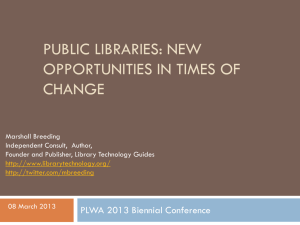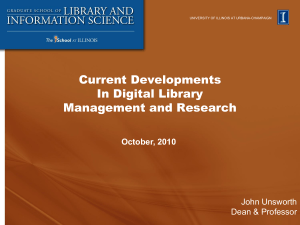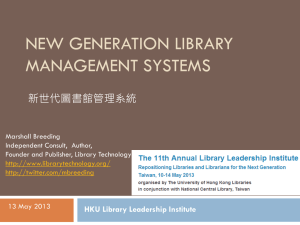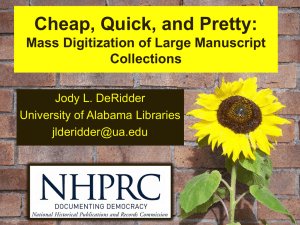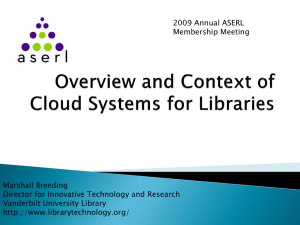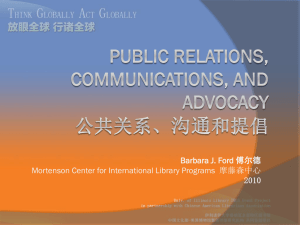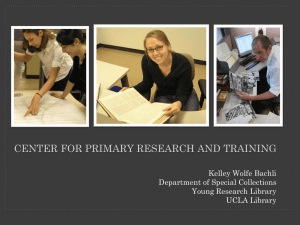Topic 5 Harnessing Technology to Support Library`s
advertisement
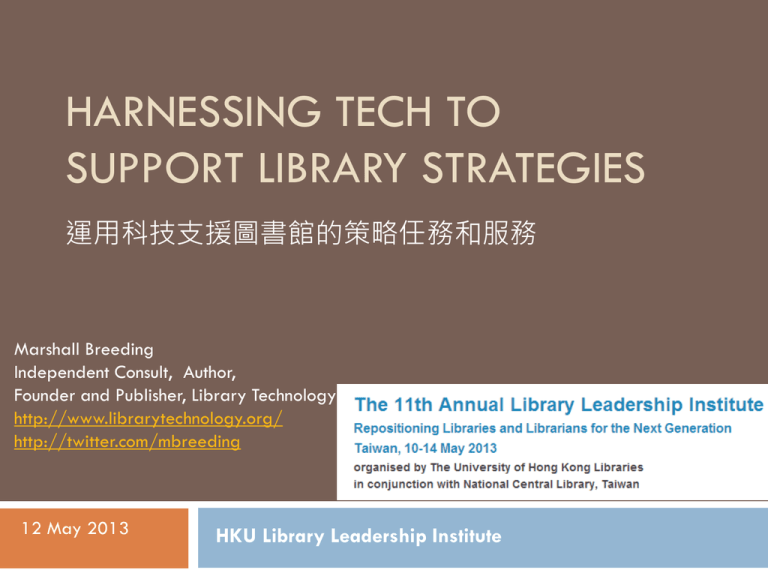
HARNESSING TECH TO SUPPORT LIBRARY STRATEGIES 運用科技支援圖書館的策略任務和服務 Marshall Breeding Independent Consult, Author, Founder and Publisher, Library Technology Guides http://www.librarytechnology.org/ http://twitter.com/mbreeding 12 May 2013 HKU Library Leadership Institute Appropriate Automation Infrastructure Current automation products out of step with current realities Majority of library collection funds spent on electronic content Majority of automation efforts support print activities New discovery solutions help with access to econtent Management of e-content continues with inadequate supporting infrastructure The Legacy Library Physical collections: Print, microfilm, manuscripts Scholarly publishing dominated by commercial publishers, societies, etc. (No open access) Library Services focus on access to physical items based on citations and bibliographic records The Online Catalog dominates as the primary search tool for books Print indexes for finding articles Key Context: Technologies in transition Client / Server > Web-based computing Beyond Web 2.0 Integration Local of social computing into core infrastructure computing shifting to cloud platforms Application Service Provider offerings standard New expectations for multi-tenant software-as-a-service Full spectrum of devices full-scale / net book / tablet / mobile Mobile the current focus, but is only one example of device and interface cycles Key Context: Libraries in Transition Academic Shift from Print > Electronic E-journal transition largely complete Circulation of print collections slowing E-books now in play (consultation > reading) All libraries: Need better tools for access to complex multi-format collections Strong emphasis on digitizing local collections Demands for enterprise integration and interoperability Key Context: Each type of library faces unique challenges Academic: Emphasis on subscribed electronic resources Public: Engaged in the management of print collections Dramatic increase in interest in E-books School: Age-appropriate resources (print and Web), textbook and media management Special: Enterprise knowledge management (Corporate, Law, Medical, etc.) Key Text: Changed expectations in metadata management Moving away from individual record-by-record creation Life cycle of metadata Manage metadata in bulk when possible E-book collections Highly shared metadata Metadata follows the supply chain, improved and enhanced along the way as needed E-journal knowledge bases, e.g. Great interest in moving toward semantic web and open linked data Very little progress in linked data for operational systems AACR2 > RDA MARC > Bibframe (http://bibframe.org/) Reshaped collections Journals now published and delivered electronically Monographs: transition to e-books underway Demand for e-book discovery and lending Digital collections: local libraries and cultural organizations actively involved in digitizing unique materials Media collections: LP, CD, DVD, Blu-Ray to streaming Heritage print collections will remain indefinitely Cumulative effect Library collections more complex than ever Library services move diverse Managing electronic and digital content harder than managing print Reassess expectations of Technology Many previous assumptions no longer apply Technology platforms scale infinitely No technical limits on how libraries share technical infrastructure Cloud technologies enable new ways of sharing metadata Build flexible systems not hardwired to any given set of workflows Reassess workflow and organizational options ILS model shaped library organizations New Library Services Platforms may enable new ways to organize how resource management and service delivery are performed New technologies more able to support strategic priorities and initiatives Social Computing Web 2.0 as a separate activity largely a distraction Important to have social orientation built directly into the software and services that comprise library infrastructure Avoid jettisoning patrons out of the library’s Web presence Find ways to effectively connect with users, connect users to each other, and especially to connect users to library content and services Academic Library Issues Greater concern with electronic scholarly articles Management: Need for consolidated approach that balances print, digital, and electronic workflows Access: discovery interfaces that maximize the value of investments in subscriptions to scholarly articles and research materials Public Library Issues Greater concern for e-books and general article databases Management: Need for consolidated approach that balances print, digital, and electronic workflows Emphasis on technologies that engage users with library programs and services Competing Models of Library Automation Traditional Proprietary Commercial ILS Traditional Open Source ILS Aleph, Voyager, Millennium, Symphony, Polaris BOOK-IT, DDELibra, Libra.se, Open Galaxy LIBERO, Amlib, Spydus, NCS Evergreen, Koha New generation Library Services Platforms Ex Libris Alma Kuali OLE (Enterprise, not cloud) OCLC WorldShare Management Services, Serials Solutions Intota Innovative Interfaces Sierra (evolving) Convergence Discovery and Management solutions will increasingly be implemented as matched sets Ex Libris: Primo / Alma Serials Solutions: Summon / Intota OCLC: WorldCat Local / WorldShare Platform Except: Kuali OLE, EBSCO Discovery Service Both depend on an ecosystem of interrelated knowledge bases API’s exposed to mix and match, but efficiencies and synergies are lost Digital dominant libraries in sight All new content acquired in electronic formats E-Journals, E-books: all acquired and accessed electronically Legacy collections fully digitized Full digitization of local specialized collections Reassess expectations of Technology Many previous assumptions no longer apply Technology platforms scale infinitely No technical limits on how libraries share technical infrastructure Cloud technologies enable new ways of sharing metadata Build flexible systems not hardwired to any given set of workflows Reassess workflow and organizational options ILS model shaped library organizations New Library Services Platforms may enable new ways to organize how resource management and service delivery are performed New technologies more able to support strategic priorities and initiatives Time to engage Transition to new technology models just underway More transformative development than in previous phases of library automation Opportunities to partner and collaborate Vendors want to create systems with long-term value Question previously held assumptions regarding the shape of technology infrastructure and services Provide leadership in defining expectations Libraries as agents of content procurement and distribution Content may be decreasingly accessed through traditional library channels Content disseminated throughout the institutional enterprise information infrastructure Learning Management Systems Departmental or disciplinary research portals Academic institutions continue to require specialists to procure content on behalf of teaching and research faculty Digital Impact on content production A given that new content will be done digitally from start to finish More dimensions of research process exposed Publishing models: pressure mounting toward open access Selection: New dynamics in peer review and subsequently promotion and tenure Research data Research Data increasingly within scope NSF data management plans Need to organize and preserve Re-use and repurpose The <r>evolution of academic information Library collections should be built from the universe of academic and scholarly content that supports research an teaching Transition from Print only > Print + electronic + digital + ??? (new media forms) Cumulative. Additive The Legacy Library Physical collections: Print, microfilm, manuscripts Scholarly publishing dominated by commercial publishers, societies, etc. (No open access) Library Services focus on access to physical items based on citations and bibliographic records The Online Catalog dominates as the primary search tool for books Print indexes for finding articles Strategic Cooperation Shared infrastructure in support of strategic collaborative relationships Opportunities to share infrastructure Examples: 2CUL Orbis Cascade Alliance Opportunities to reconsider automation implementation strategies One library = 1 ILS? Ability to share infrastructure across organizational boundaries? Time to Invest in Technology Libraries in general lack the proper tools to manage and deliver access to their reshaped collections Library and campus tools may seem stilted and primitive relative to what students experience outside the campus domain Tradition of under-investment and deferred maintenance or replacements of technology infrastructure in the library Dearth of transformative technology options? UCSD Research Data Curation Services Centers of Preservation Increased involvement in production of digital content demands institutional commitment to longterm digital preservation Digital Curation: create, organize, access, preservation Libraries as a whole in the early stages of digital preservation Resource Sharing Strategies Strategic interest in Resource Sharing Supplement local collections Provide expanded universe of content to library users Print – Digital – Electronic Lower operational Costs Step into more powerful automation environment Resource Sharing issues Local Control and Branding Compromises to policies and practices Impact on collection development Targeted Opportunities for collaborative operations Technical collections among partners Services Costs for delivery Reduce traditional ILL costs Impact on Library Users Access to larger aggregate collections Enhanced Discovery: able to gain access to larger universe of content Convenient delivery of materials Manage expectations on delivery times Budget planning Increased activity comes with cost implications Buy less, borrow more Factor in courier costs Technology costs Integrated Library System Search: Holdings Model: Multi-branch Independent Library System Main Facility Bibliographic Database Branch 1 Branch 5 Branch 2 Branch 6 Branch 3 Branch 7 Branch 4 Branch 8 Library System Patrons use Circulation features to request items from other branches Floating Collections may reduce workload for Inter-branch transfers WorldCat Resource Sharing Patron has Citation for item not held by Library WorldCat Interlibrary Loan Request Form User: Password: Needed by: WorldCat Resource Sharing Request Submission Dec 30, 2012 5:00pm ILLiad Holdings Main Facility Bibliographic Database Branch 1 Branch 5 Branch 2 Branch 6 Branch 3 Branch 7 Branch 4 Branch 8 Library System A ILS Synchronization Resource tracking and fulfillment Interlibrary Loan Personnel Consortial Resource Sharing System Search: Bibliographic Database Holdings Holdings Main Facility Main Facility Branch 1 Branch 5 Branch 2 Branch 6 Branch 3 Branch 7 Branch 4 Branch 8 NCIP NCIP Discovery and Request Management Routines Library System A Bibliographic Database Branch 1 Branch 5 Branch 2 Branch 6 Branch 3 Branch 7 Branch 4 Branch 8 Library System D Bibliographic Database Bibliographic Database Holdings Holdings Main Facility Main Facility Branch 1 Branch 5 Branch 2 Branch 6 Branch 3 Branch 7 Branch 4 Branch 8 NCIP ISO Z39.50 NCIP SIP ILL Inter-System Communications Library System B NCIP Bibliographic Database Branch 1 Branch 5 Branch 2 Branch 6 Branch 3 Branch 7 Branch 4 Branch 8 Library System E Staff Fulfillment Tools Bibliographic Database Holdings Holdings Main Facility Main Facility Branch 1 Branch 5 Branch 2 Branch 6 Branch 3 Branch 4 Resource Sharing Application Branch 1 Branch 5 Branch 2 Branch 6 Branch 7 Branch 3 Branch 7 Branch 8 Branch 4 Branch 8 Library System C NCIP NCIP Bibliographic Database Library System F Shared Consortial ILS Search: Holdings Model: Multiple independent libraries in a Consortium Share an ILS Bibliographic Database Library 1 Library 6 Library 2 Library 7 Library 3 Library 8 Library 4 Library 9 Library 5 Library 10 Shared Consortia System ILS configured To support Direct consortial Borrowing through Circulation Module Strategic Cooperation and Resource sharing Efforts on many fronts to cooperate and consolidate Many regional consortia merging (Example: Illinois Heartland Library System) State-wide or national implementations New Zealand: Kōtui, Te Puna Software-as-a-service or “cloud” based implementations Many libraries share computing infrastructure and data resources Auckland City Libraries 7 separate library services merged in 2010 MyLibraryNYC Auckland City Libraries 7 separate library services merged in 2010 OhioLink Iceland Libraries South Australia SA Public Library Network 140 Public Libraries Chile Georgia PINES 275 Libraries 140 Counties 9.6 million books Single Library Card 43% of population in Georgia Northern Ireland Recently consolidated from 4 regional networks into one 96 branch libraries http://www.ni-libraries.net/ 18 mobile libraries Collections managed through single Axiell OpenGalaxy LMS Illinois Heartland Library Consortium Largest Consortium in US by Number of Members Orbis Cascade Alliance 37 Academic Libraries Combined enrollment of 258,000 9 million titles 1997: implemented dual INN-Reach systems Orbis and Cascade consortia merged in 2003 Moved from INN-Reach to OCLC Navigator / VDX in 2008 Current strategy to move to shared LMS based on Ex Libris Alma Orbis-Cascade Alliance Denmark Denmark Shared LMS Common Tender for joint library system February 88 municipalities: 90 percent of Danish population Public 2013 + School libraries Process managed by Kombit: non-profit organization owned by Danish Local Authorities 2CUL Shared Services: Collection Development Technical Services Shared Infrastructure?: Illinois Heartland Library Consortium Largest Consortium in US by Number of Members Orbis Cascade Alliance 37 Academic Libraries Combined enrollment of 258,000 9 million titles 1997: implemented dual INN-Reach systems Orbis and Cascade consortia merged in 2003 Moved from INN-Reach to OCLC Navigator / VDX in 2008 Current strategy to move to shared LMS based on Ex Libris Alma Strategic Planning Reviewing what’s behind your motive to change your software and assessing your needs based on your budget Reasons to consider Technology Changes Obsolete or non-supported system Lost confidence in current supplier Library can no longer operate optimally with current tech environment Need a environment which delivers better resource sharing or collaboration opportunities Timing issues Immediate need Interested in alternative options once they become standard options Early adopter Defer tech investment Waiting for the perfect solution will result in indefinite deferment Can your library justify a Lateral Move? Move from a product to a similar product from another supplier Same generation / scope / workflows Each of the major products offers both strengths and weaknesses Will a lateral move result in fewer problems or different problems? Key consideration is whether your system supports the strategic business needs of your library Open Source vs Proprietary Open source may provide more opportunity for local control of strategic development Open Source ILS available as a complete turnkey solution Open source software have fewer mature modules and features than well-established proprietary systems Cost mostly equivalent. Highly dependent on specific scenario. Both options document examples of lower cost. Decision should be based on business requirements and tangible benefits Both open source and proprietary ILS involve relationships with vendors Organizational planning Planning and preparing for new tech project Library Services Platform = largescale change Requires broad-based decision-making process Committees / Teams Leverage expertise from all areas of the library Prepare for change processes Review and revise operational workflows Operationalize new system into the fabric of the library New Discovery product = moderate change Operations remain largely unchanged New interface for public access Some changes needed to optimize support for discovery product Metadata issues Cataloging practices May cover up, but not cure misalignment of automation software with library strategies Evaluating and selecting Technology Deployment options Software-as-a-service Proprietary Open Source Participate in a shared ILS – statewide, regional, or consortial Locally-installed server Proprietary Open Source Cost Spectrum Standalone Implementation Consortium participant Constant annual cost Licensed software Lower cost / Higher resource sharing SaaS Highest cost / Least resource sharing High start-up cost / Lower ongoing cost Open source Many cost variables Cost Issues Consider the total cost of ownership Direct costs Vendor payments: software licensing, support, training, conversion Hardware purchase and maintenance Hosting costs: in-house or outsourced SaaS Subscriptions Indirect costs Procurement overhead: personnel time devoted to selection process, including committee meetings, prep, vendor demos, etc. Increased workload for systems and technical services personnel Decreased productivity during transition Procurement options: sole source Purchase additional software from existing supplier Internal justification often required competitive procurement Submit procurement documents to qualified suppliers Incumbent often one of the competitors Procurement processes Request for Information Method to gain in-depth understanding of competitive offerings Often a preliminary process to RFP Request for Proposals Solicits responses to detailed specifications Specific / binding cost proposal Product / support / company viability Many boilerplate documents available – be wary Core specifications can be licensed Progressive Procurement Strategy Do not reinforce legacy concepts and practices Do not over-specify detailed functionality Define a process that will result in a forwardlooking result Assume that rates of change will increase Articulate your organizational strategy and vision for technology Give respondents leeway to express how they can fulfill your vision Time to engage Transition to new technology models just underway More transformative development than in previous phases of library automation Opportunities to partner and collaborate Vendors want to create systems with long-term value Question previously held assumptions regarding the shape of technology infrastructure and services Provide leadership in defining expectations Concluding thoughts Urgency to align technology with library missions Innovate locally Collaborate aggressively collectively Drive strategic development Questions and discussion

